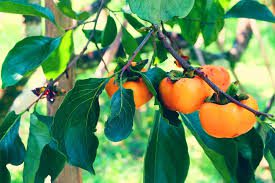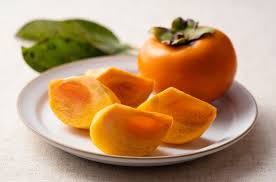Persimmons, scientifically known as Diospyros, are delightful fruits that come in various shapes and colors. These fruits belong to the ebony family, Ebenaceae. With their scientific name originating from Greek words meaning “divine fruit,” persimmons indeed offer a heavenly taste and a plethora of health benefits.
These fruits are generally divided into two main types: astringent and non-astringent. Astringent persimmons, such as the Hachiya variety, are typically rich in tannins, giving them a puckering taste when unripe. As they ripen, the tannins diminish, transforming the fruit into a lusciously sweet delicacy. Non-astringent varieties, like Fuyu, can be enjoyed while still firm and crisp, showcasing a sweet flavor throughout their ripening process.
Persimmons are a powerhouse of nutrients, containing essential vitamins such as vitamin A, C, and E. They also boast dietary fiber, which aids in digestion and promotes a healthy gut. Additionally, these fruits are a good source of minerals like potassium and manganese, contributing to overall well-being.
In terms of appearance, persimmons exhibit a vibrant spectrum, ranging from deep orange to red hues. The skin is often smooth and glossy, encapsulating the succulent flesh within. The interior may contain seeds, but some varieties are seedless, providing a hassle-free eating experience.
Culinary enthusiasts embrace persimmons for their versatility. Whether consumed fresh, sliced into salads, or incorporated into desserts, their unique flavor adds a sweet and delectable touch. Persimmons can also be dried, creating a chewy, concentrated treat, perfect for snacking or baking.
Beyond their culinary appeal, persimmons have been recognized in traditional medicine for their potential health benefits. Some studies suggest that these fruits may contribute to heart health, support immune function, and aid in weight management due to their low calorie and high fiber content.
Cultivation-wise, persimmon trees thrive in temperate climates, requiring well-drained soil and ample sunlight. With proper care, these trees bear fruit in late autumn, offering a bountiful harvest.
In addition, persimmons, with their scientific elegance as Diospyros, grace our tables with a divine blend of taste and health benefits. Whether enjoyed fresh, dried, or in various culinary creations, these fruits continue to captivate palates worldwide.
Read Also: Sheep and Goat Housing Complete Guide
The History of Persimmons

Throughout history, persimmons have played a noteworthy role, tracing their roots back to ancient times. The origins of these delectable fruits can be traced to China, where they have been cultivated for over two thousand years. From China, the cultivation of persimmons spread to Korea and Japan, becoming integral parts of these countries’ culinary and cultural landscapes.
Persimmons found their way to Europe in the 19th century, primarily through explorers and traders who were enchanted by their unique taste and vibrant appearance. European botanists and horticulturists began studying and cultivating different varieties of persimmons, contributing to the global dissemination of these fruits.
In the United States, persimmon cultivation gained momentum in the 19th and early 20th centuries. Initially introduced by immigrants, the fruit gradually found its place in American orchards. American persimmon varieties, such as the native Diospyros virginiana, became sought-after additions to orchards across the country.
The cultural significance of persimmons is evident in various societies. In China and Japan, these fruits symbolize good fortune and prosperity. They are often exchanged as gifts during special occasions, such as New Year celebrations. In Korea, persimmons are linked to longevity and are commonly enjoyed during the Chuseok festival, a time of thanksgiving and family reunions.
As persimmons continued to spread globally, they became more than just a culinary delight. Their presence in traditional medicine and folklore further solidified their importance in different cultures. Ancient herbalists valued persimmons for their potential health benefits, attributing properties that supported digestion and overall well-being.
Today, persimmons maintain their popularity worldwide, with diverse varieties cultivated and enjoyed in various cuisines. Their rich history and cultural significance make persimmons not just a fruit but a symbol of tradition, prosperity, and the enduring connection between people and the earth’s bountiful offerings.
Nutritional Value of Persimmons

Persimmons are a nutritional powerhouse, offering a range of vitamins, minerals, and other essential compounds that contribute to a healthy diet.
1. Vitamins:
Vitamin A: Persimmons are rich in vitamin A, supporting vision, immune function, and skin health.
Vitamin C: These fruits provide a significant dose of vitamin C, an antioxidant that boosts the immune system and promotes skin health.
2. Minerals:
Potassium: Persimmons contain potassium, which is essential for maintaining proper heart and muscle function and helps regulate blood pressure.
Manganese: This mineral is important for bone health, blood clotting, and reducing inflammation.
3. Dietary Fiber: Persimmons are an excellent source of dietary fiber, promoting digestive health and helping to prevent constipation.
4. Antioxidants: Rich in antioxidants, persimmons help combat oxidative stress in the body, potentially reducing the risk of chronic diseases.
5. Low in Calories: Persimmons are relatively low in calories, making them a healthy snack or addition to meals for those looking to manage their calorie intake.
6. Natural Sugars: While sweet, persimmons contain natural sugars that contribute to their delightful taste without the need for added sugars.
Incorporating persimmons into a balanced diet can provide a range of essential nutrients, supporting overall health and well-being. Whether enjoyed fresh, dried, or in various culinary creations, persimmons offer a tasty and nutritious addition to any meal.
Read Also: Guide On How To Increase Goats Milk
Health Benefits of Persimmons

Persimmons offer a variety of health benefits, making them a valuable addition to a balanced diet. Here are some key advantages associated with consuming persimmons:
1. Antioxidant Protection: Persimmons are rich in antioxidants, including vitamin C and various phytochemicals. These compounds help neutralize free radicals in the body, reducing oxidative stress and potentially lowering the risk of chronic diseases.
2. Heart Health: The potassium content in persimmons supports heart health by helping regulate blood pressure. Additionally, the dietary fiber in these fruits may contribute to lower cholesterol levels, promoting cardiovascular well-being.
3. Digestive Health: With a high dietary fiber content, persimmons promote healthy digestion and regular bowel movements. Fiber helps prevent constipation and supports a well-functioning digestive system.
4. Immune System Support: The combination of vitamin C and other antioxidants in persimmons strengthens the immune system, aiding the body’s defense against infections and illnesses.
5. Vision Protection: Persimmons are a good source of vitamin A, which is essential for maintaining healthy vision. This vitamin plays a crucial role in the functioning of the retina and may help prevent age-related macular degeneration.
6. Weight Management: Being low in calories and high in fiber, persimmons can be a satisfying and nutritious snack for those looking to manage their weight. The fiber content promotes a feeling of fullness, reducing overall calorie intake.
7. Anti-Inflammatory Properties: Some compounds found in persimmons exhibit anti-inflammatory properties, which may help reduce inflammation in the body. Chronic inflammation is associated with various diseases, so incorporating anti-inflammatory foods can be beneficial.
8. Bone Health: The presence of minerals like manganese in persimmons contributes to bone health. Manganese is involved in bone formation and maintaining bone density.
9. Hydration: Persimmons have a high water content, contributing to overall hydration. Proper hydration is essential for various bodily functions, including temperature regulation and nutrient transport.
Incorporating persimmons into a diverse and balanced diet can provide these health benefits, making them a tasty and nutritious choice for overall well-being.
How to Grow Persimmons (Growing Guide)
Growing persimmons can be a rewarding experience, and with the right care, you can enjoy a bountiful harvest. Here’s a basic guide on how to grow persimmons:
1. Climate and Soil: Persimmons thrive in temperate climates with well-drained soil. They prefer slightly acidic to neutral soil pH. Ensure the planting site receives full sunlight for optimal growth.
2. Choosing the Right Variety: Select a persimmon variety that is well-suited to your climate and preferences. Common varieties include Fuyu, Hachiya, and American persimmon (Diospyros virginiana).
3. Planting: Plant persimmons in late winter or early spring when the soil is workable. Dig a hole large enough to accommodate the root system, and place the tree at the same depth as it was in the nursery container. Space multiple trees according to the specific variety’s recommended planting distance.
4. Watering: Provide consistent watering, especially during dry periods. Persimmons prefer evenly moist soil. However, they are somewhat drought-tolerant once established.
5. Mulching: Apply a layer of organic mulch around the base of the tree to conserve moisture, suppress weeds, and regulate soil temperature. Mulching also helps prevent competition from grass.
6. Pruning: Prune persimmons to shape the tree and remove dead or crowded branches. Pruning is typically done in late winter or early spring before new growth starts.
7. Fertilizing: Use a balanced fertilizer in spring and early summer to promote healthy growth. Follow the recommended application rates for your specific persimmon variety.
8. Protecting Against Pests: Keep an eye out for common pests such as aphids and scale insects. Treat infestations promptly with appropriate insecticides if necessary.
9. Harvesting: Persimmons are typically ready for harvest in late autumn. Harvest fruits when they have reached the desired color and size. Some varieties are best enjoyed when fully ripe, while others can be consumed when still firm.
10. Winter Protection: In regions with harsh winters, consider protecting young persimmon trees by wrapping the trunk with burlap or using tree wraps to prevent sunscald and frost damage.
Read Also: Breathtaking Exercise You Must Avoid If You Must Live Long and Healthy

